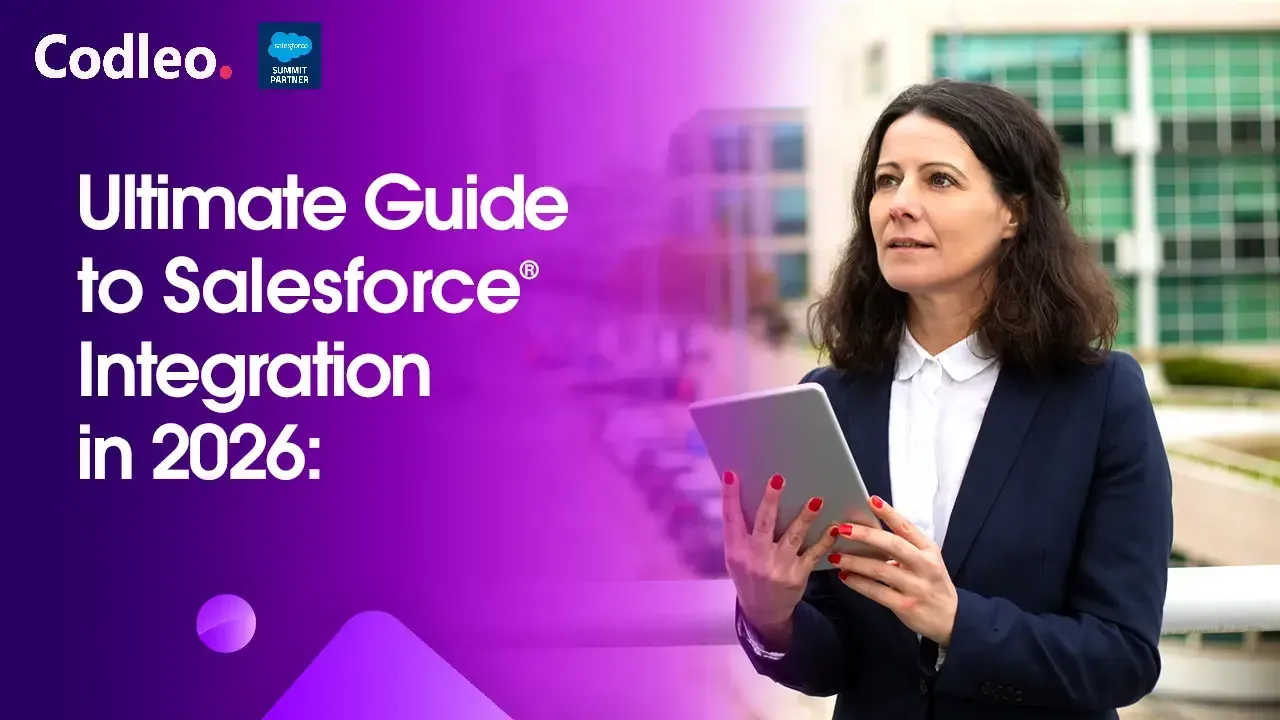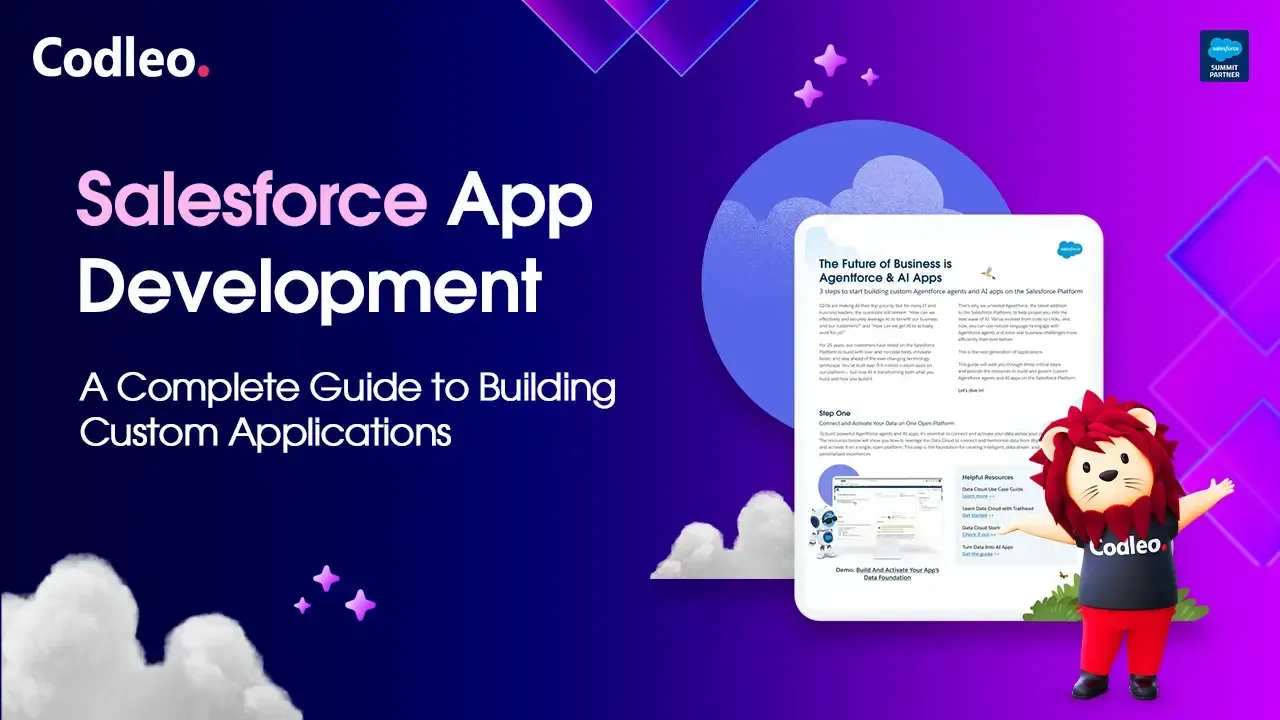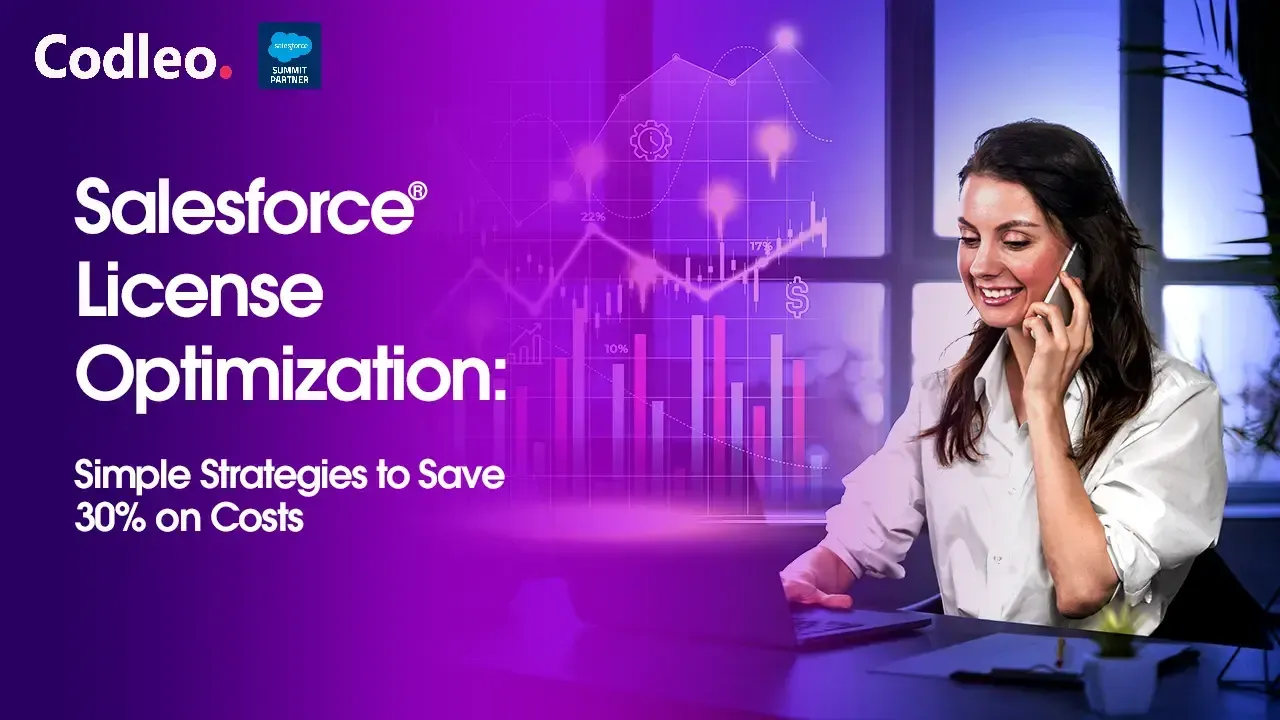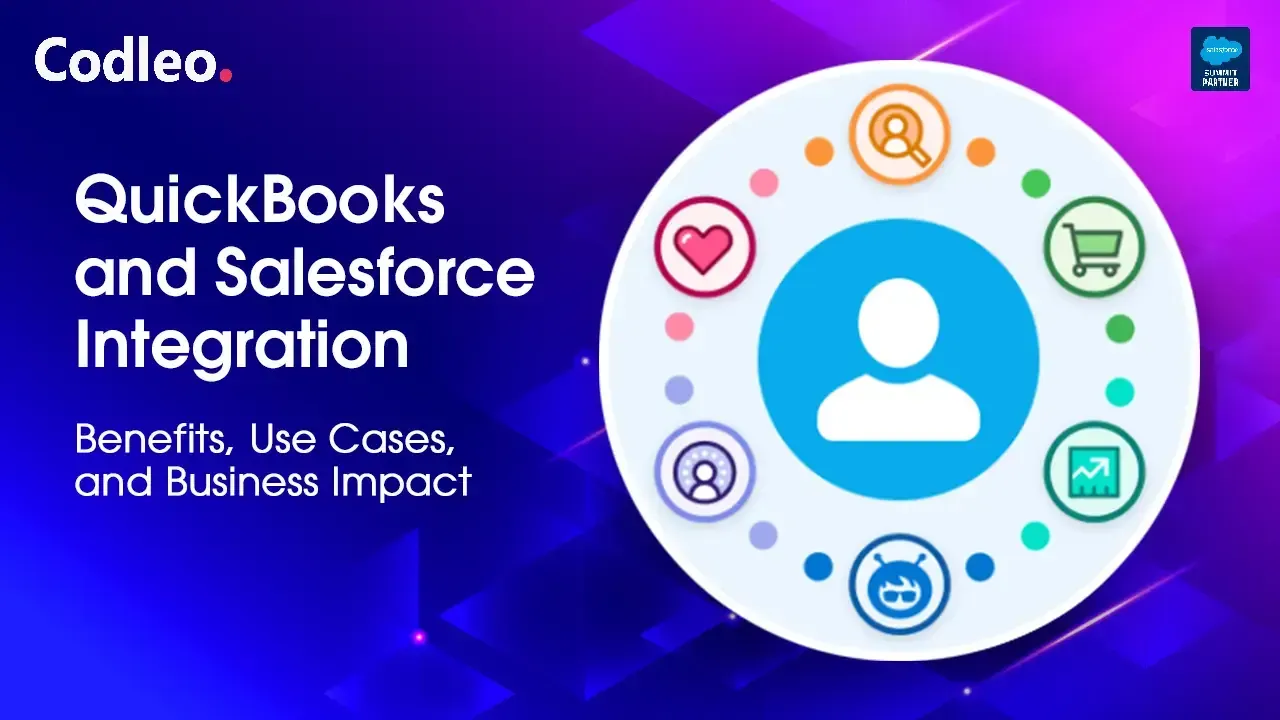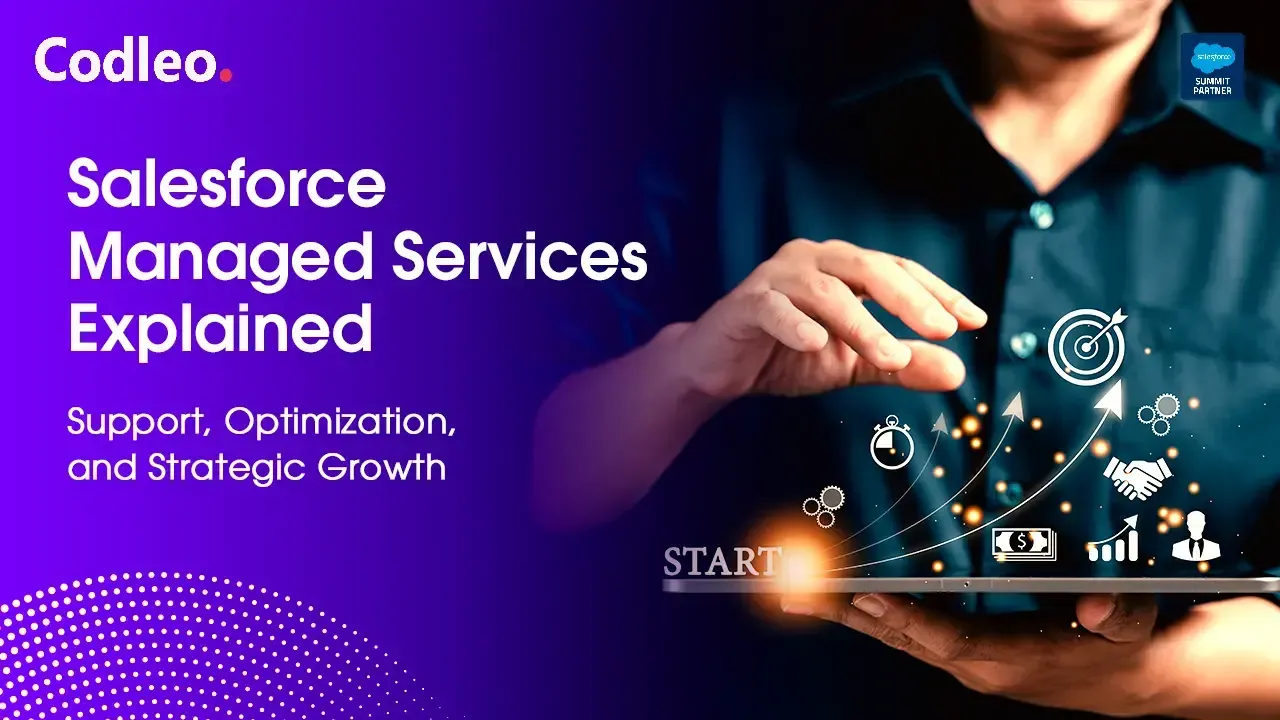Publish date:
If you’re a CFO or Salesforce admin, you’ve probably asked yourself this:
“How many of our Salesforce licenses are actually being used?”
Did you know that 40% of Salesforce customers spend too much money because they choose the wrong or unused licenses? At first, Salesforce licenses may seem straightforward. However, there are many types and pricing models to consider.
Many companies waste money on Salesforce CRM because they have inactive users.
It's not essential to consider just how valuable Salesforce is. Instead, we should focus on whether each license is worth it.
That's where managing Salesforce licenses comes in. If you don't have a sound system, you may be paying for seats that you don't use.
Choosing the wrong licenses can lead to overpaying or missing essential features. It can be stressful and confusing to decide which ones to pick.
In this guide, we will explain the different types of Salesforce licenses. We will also describe their features to help you choose the best one for your organization. Whether you are a small startup or a large company, understanding Salesforce licenses is essential to getting the most from your investment.
What is a Salesforce License?
A Salesforce license is an agreement that grants a user access to Salesforce products and features. It works like a ticket that shows what each user can do on the Salesforce platform.
Every person in a company that uses Salesforce must have a license. This license determines what they can see, change, and do in your Salesforce account.
How Does a Salesforce Licensing Model Work?
When your company subscribes to Salesforce, you must buy a license for each user who needs access. Each license type offers specific features and capabilities.
Depending on whether a user is in sales, partner management, or custom app development, they will require different license types.
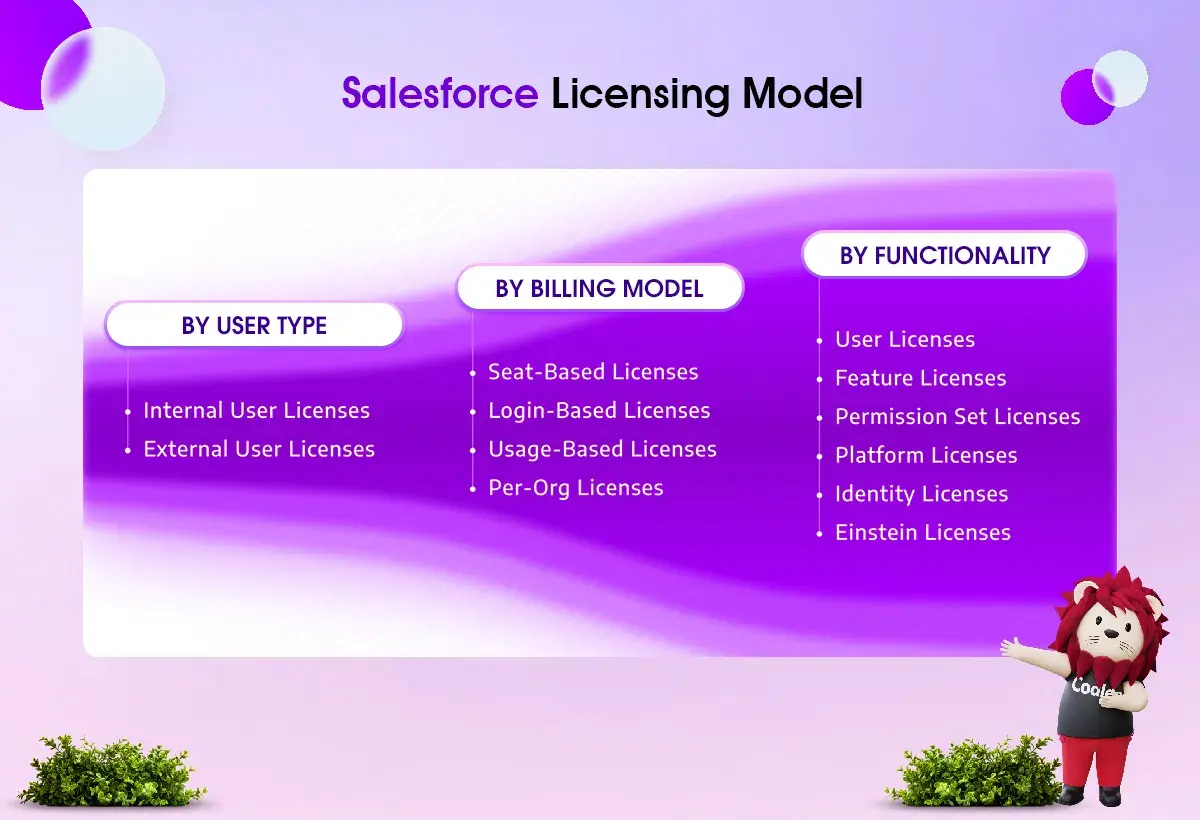
By User Type
-
Internal User Licenses: These include licenses like Salesforce CRM (Full), Salesforce Platform, and Chatter Only.
-
External User Licenses: These are for users outside the organization and include Customer Community, Customer Community Plus, Partner Community, External App, and Channel Account.
By Billing Model
-
Seat-Based Licenses: Each license is assigned to a specific user, usually for internal users.
-
Login-Based Licenses: These are based on the number of logins per month and are suitable for external users who access the system infrequently.
-
Usage-Based Licenses: Pricing depends on how much the service is used, including API calls, data storage, and transaction volume.
-
Per-Organization Licenses: These cover the entire organization, regardless of the number of users.
By Functionality
-
User Licenses: Examples are Salesforce CRM, Salesforce Platform, and Chatter Free.
-
Feature Licenses: These include Marketing, Flow, and Service Cloud users.
-
Permission Set Licenses
-
Platform Licenses: Also known as Lightning Platform and Platform Plus.
-
Identity Licenses
-
Einstein Licenses include features such as Einstein Search, Opportunity Scoring, Prediction Builder, and Next Best Action.
Common Types of Salesforce Licenses: Internal vs. External
Salesforce divides licenses into two main types: internal permits for employees and external licenses for customers or partners.
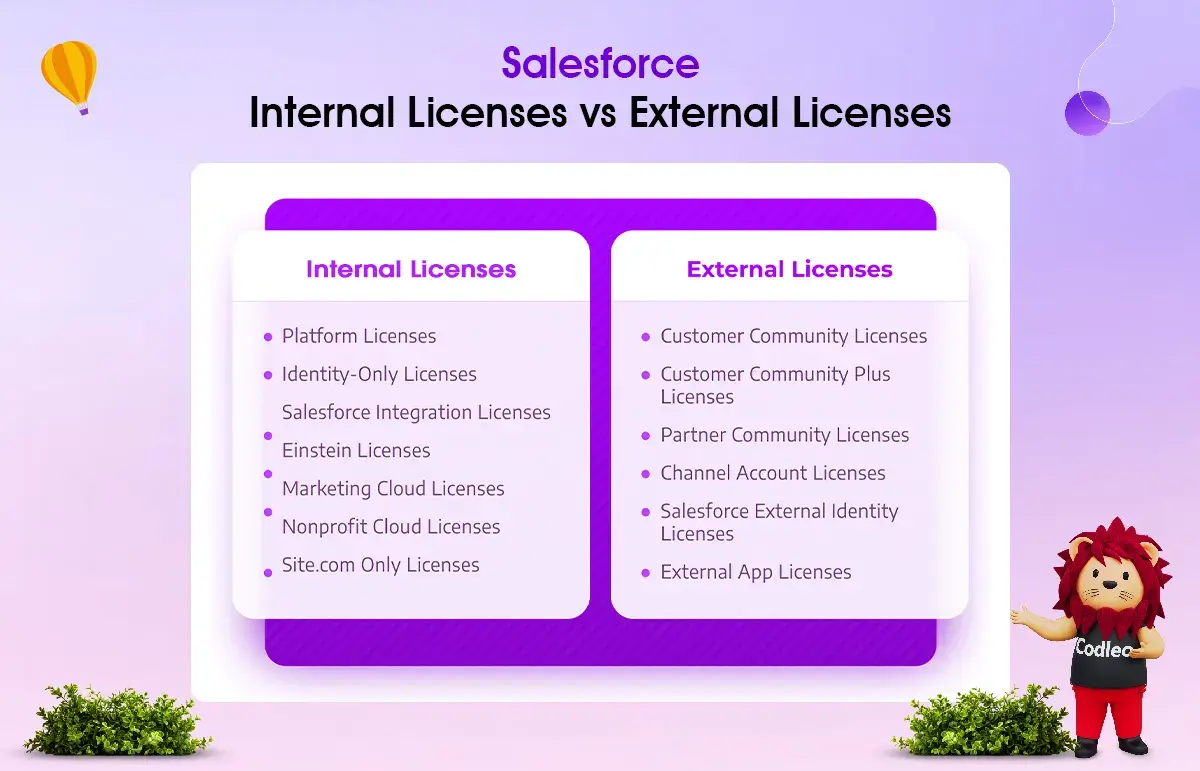
What Are Internal Salesforce Licenses?
Internal licenses are for employees only. The Salesforce internal license offers several options that go beyond basic user and feature licenses.
-
Platform licenses are available in two editions: Enterprise and Unlimited. Salesforce Platform Login, Lightning Platform – One App, Force.com – App Subscription, Company Community User, and Developer licenses are among them. Accounts, contacts, reports, and automation tools like Flow and Apex are all accessible with these licenses. They are helpful for users who primarily work with custom applications rather than the core CRM features.
-
Identity Only licenses allow users to log in to Salesforce using single sign-on (SSO) without needing a full CRM license. This option is helpful for organizations that want to manage access across different systems while keeping their information secure.
-
Salesforce Integration User Licenses allow businesses to control which data integration users can access. It helps improve oversight and tracking of all actions taken during each integration point.
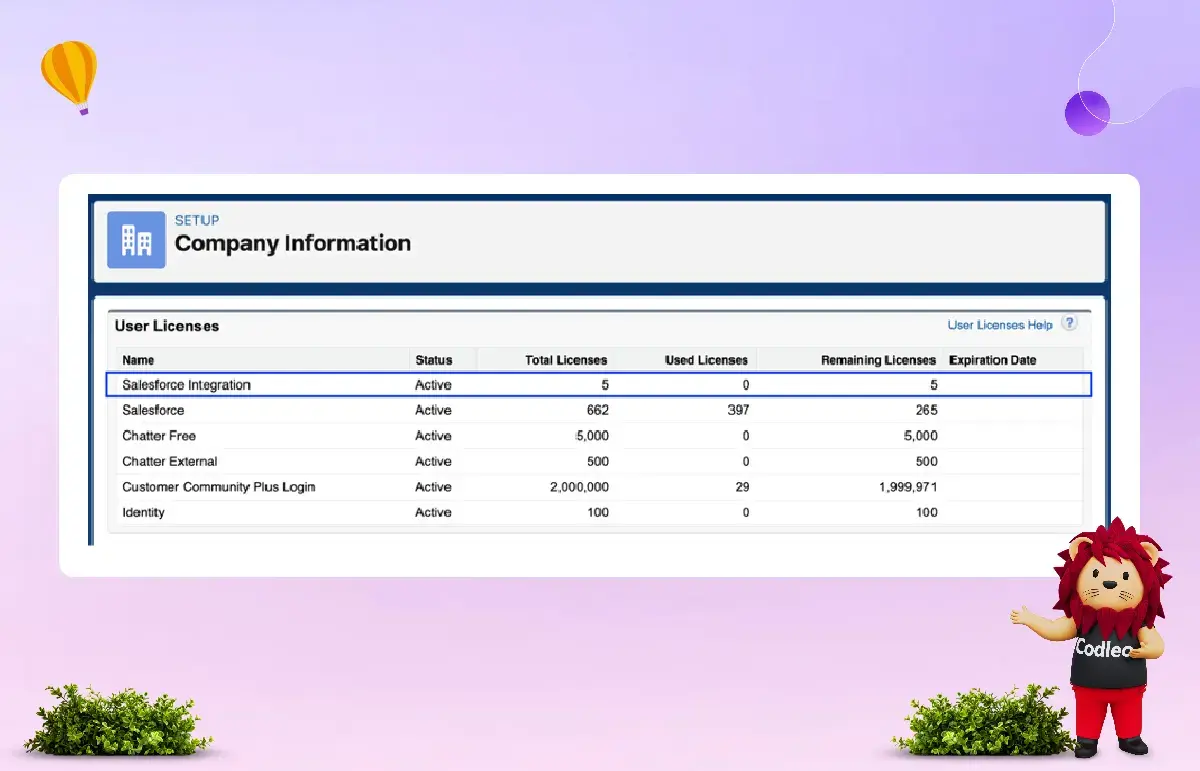
-
Salesforce Einstein licenses for Sales, Service, Marketing Cloud, and Salesforce Platform add AI features to Salesforce. These features include predictive analytics and automated insights. With these advanced licenses, teams can make better decisions.
-
Marketing Cloud licenses give you access to Salesforce’s marketing automation tools. These tools help manage campaigns, improve customer experiences, and analyze data. Marketing teams need these licenses to enhance engagement.
-
MC Account Engagement, formerly known as Pardot, offers B2B marketing automation tools for lead generation, nurturing, and campaign management. These tools help organizations manage leads more efficiently, especially those with complex sales processes.
License costs depend on the type and edition you choose. Monthly pricing starts at $25 per user and can reach $500 for the most comprehensive plans. Knowing these differences will help you create an affordable licensing strategy.
What are External Salesforce Licenses?
Experience Cloud, formerly called Communities, uses community licenses that are similar to standard Salesforce internal licenses.
It also has different license types for users outside of your organization who are not employees.
Users with a member-based license can access a community as often as they need. However, they will not be able to access the internal Salesforce organization.
What Are the Different Salesforce Experience License Types?
Customer Community licenses are best for situations where outside users need limited access and can help themselves.
-
Customer order tracking,
-
Case management,
-
Knowledge base access.
Customer Community Plus licenses help businesses work together more effectively.
-
Team-based work,
-
Data sharing capabilities,
-
Improved customer service features.
Partner Community licenses help you manage relationships with your business partners.
-
Lead and opportunity sharing,
-
Partner relationship management,
-
Customizable partner portal access.
Channel Account licenses support up to 40 partner users per partner account. It is a cost-effective option for organizations that have multiple contacts at each partner company.
External App License: External users can use custom apps designed for customers to connect and interact with your brand without exposing extensive CRM data.
The Salesforce External Identity License is designed for external users, such as customers, partners, or stakeholders. It lets them register themselves, log in, manage their profiles, and access connected sites and apps. However, it does not give them full access to CRM features.
Experience Cloud licenses have different pricing models compared to internal user licenses. You can purchase them based on individual users or on how often people log in, depending on your usage patterns.
Individual licenses are more economical if users log in more than 4 times per month.
Also, Salesforce Experience Cloud offers two types of site access licenses:
-
Guest User License: This license is for people using Site.com or Experience Cloud sites. Guest users can view public pages and content on these sites. Guest User licenses are included in the Enterprise, Unlimited, Performance, and Developer editions, with varying limits on the number of permits available. They cannot be purchased separately.
-
Site.com Only License: This internal license is for users who want access to Site.com features without the standard CRM features. It is only available in the Performance, Unlimited, and Enterprise editions. This license allows unlimited custom tabs for a single custom app. Users must also have a Site.com Contributor or Publisher feature license.
Login-Based vs Seat-Based Licenses
One crucial factor to consider with Salesforce licenses is whether to choose login-based or seat-based licenses.
-
Seat-based licenses: These licenses are given to specific people who use Salesforce often and heavily, such as employees who log in every day.
-
Login-based licenses: Users are charged based on how many times they log in each month. It applies to external or occasional users, like seasonal employees or customers who log in infrequently.
If you need help managing Salesforce licenses and saving money, the Codleo team is ready to assist you.
-
select the appropriate licenses,
-
utilize permission sets and profiles,
-
conduct regular license audits,
-
Make custom reports and dashboards in Salesforce to track user logins and measure adoption.
Salesforce Developer License vs. Platform License
The Salesforce Developer License and the Salesforce Platform License serve different purposes and offer distinct features. They differ in what you can access, how you can use them, and their limitations.
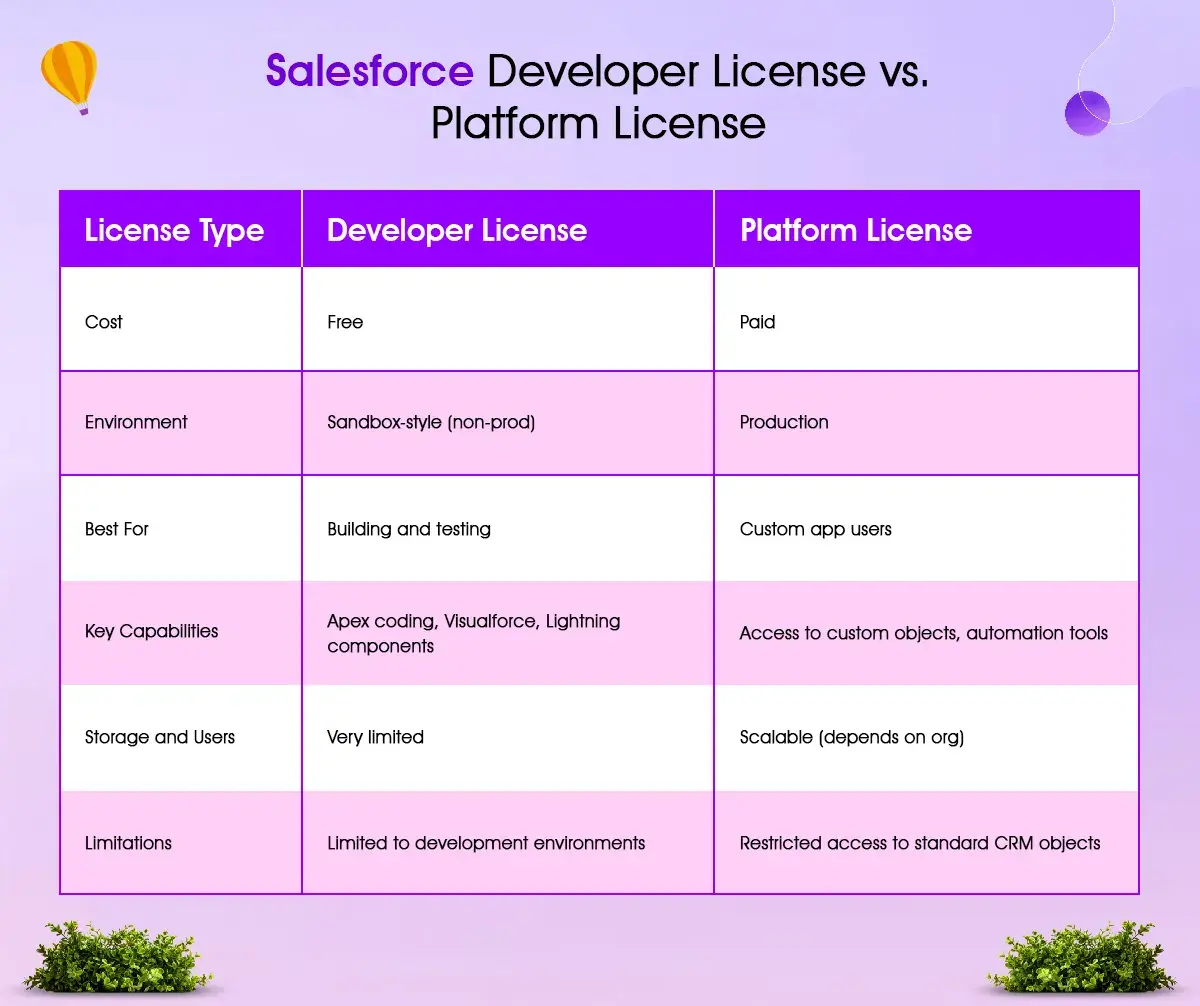
Salesforce Developer License
Salesforce Developer licenses are for Development Orgs. These licenses are primarily for individual developers or teams who want to build and test apps or learn Salesforce without paying for a permit.
Key features:
-
It's free and available with Salesforce Developer Edition.
-
You have complete access to Sales Cloud, Service Cloud, and custom app development.
-
You can only have a limited number of users, storage, and API calls. You can store up to 2 MB of data and 5 MB of files. You can make up to 15,000 API calls every 24 hours.
-
Developers use this to build, test, and try out Salesforce apps.
-
Not for production use.
Salesforce Platform License
Salesforce Platform Licenses enable organizations to develop custom apps in production environments. They are ideal for groups that want to provide non-sales or non-service users access to Salesforce for internal applications or operational dashboards.
Key features:
-
This type of Salesforce license requires payment for users who need to access custom apps that are built on the Salesforce Platform.
-
You can access standard and custom objects, reports, dashboards, and tools like Flow. However, you cannot access core CRM features such as Leads, Opportunities, Cases, or Campaigns.
-
Employees who do not need complete CRM features can use custom business apps built on Salesforce.
Platform licenses come in two varieties.
Salesforce Platform License: Platform Starter vs. Platform Plus
-
Platform Starter, formerly known as Lightning Platform, provides access to 10 custom objects. It makes it suitable for simple applications with limited data models.
-
Platform Plus, previously known as Lightning Platform Plus, offers access to 110 custom objects. This feature helps build complex, data-intensive custom applications.
Both options include automation tools such as Flow and Apex. Developers can create advanced solutions without needing full CRM licenses. Platform licenses allow you to use Salesforce's framework to build custom applications without all the CRM features.
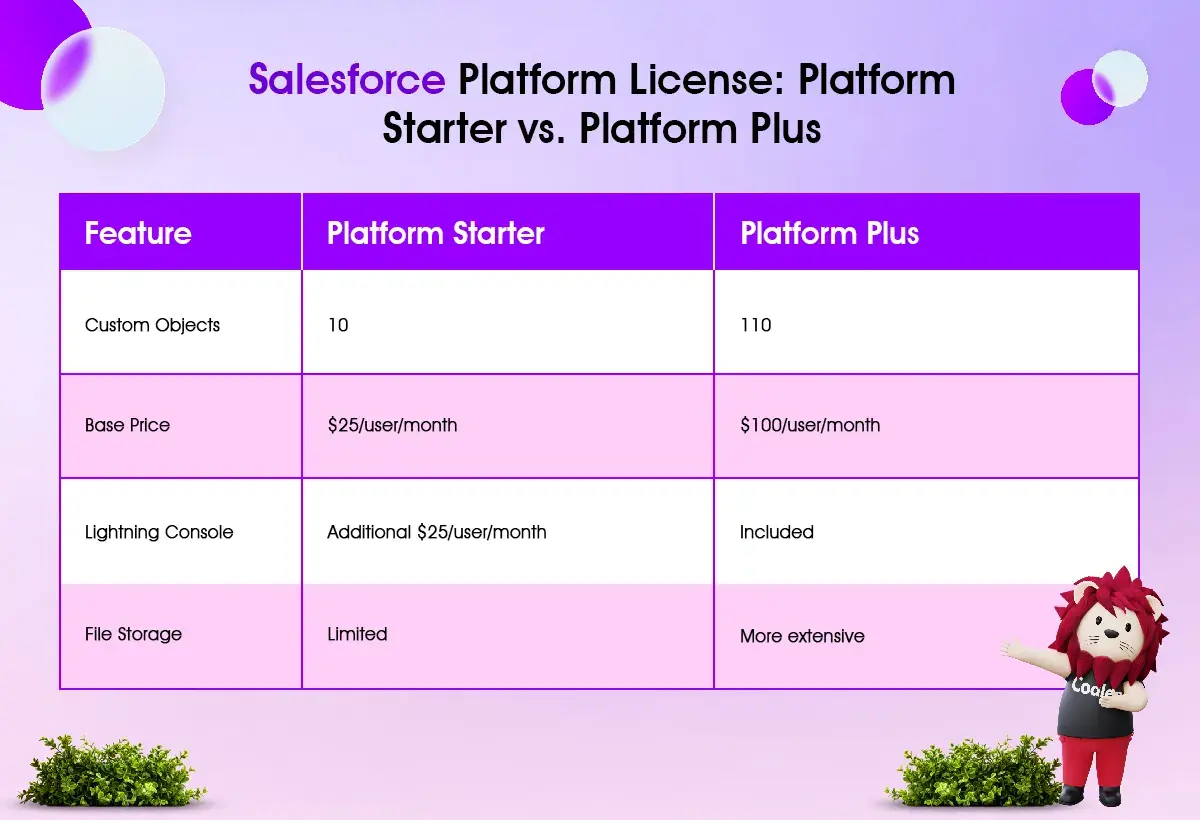
Both versions come with core features like:
-
Process Automation,
-
Lightning App Builder,
-
AppExchange access,
-
Identity for Employees,
-
Customizable reports and dashboards.
Platform Plus offers 11 times more capacity for custom objects. This feature makes it ideal for organizations with complex data structures.
Salesforce also offers a Platform Login & Dev Credits option for $1,000, which includes 10,000 credits and 200 logins.
Salesforce Editions vs. License Types Pricing Comparison
Organizations often struggle to understand the difference between Salesforce editions and license types. This difference affects subscription costs.
Salesforce Editions are packages that include all the features your organization purchases. These Editions determine the basic functionalities available in your Salesforce Sales and Service Clouds.
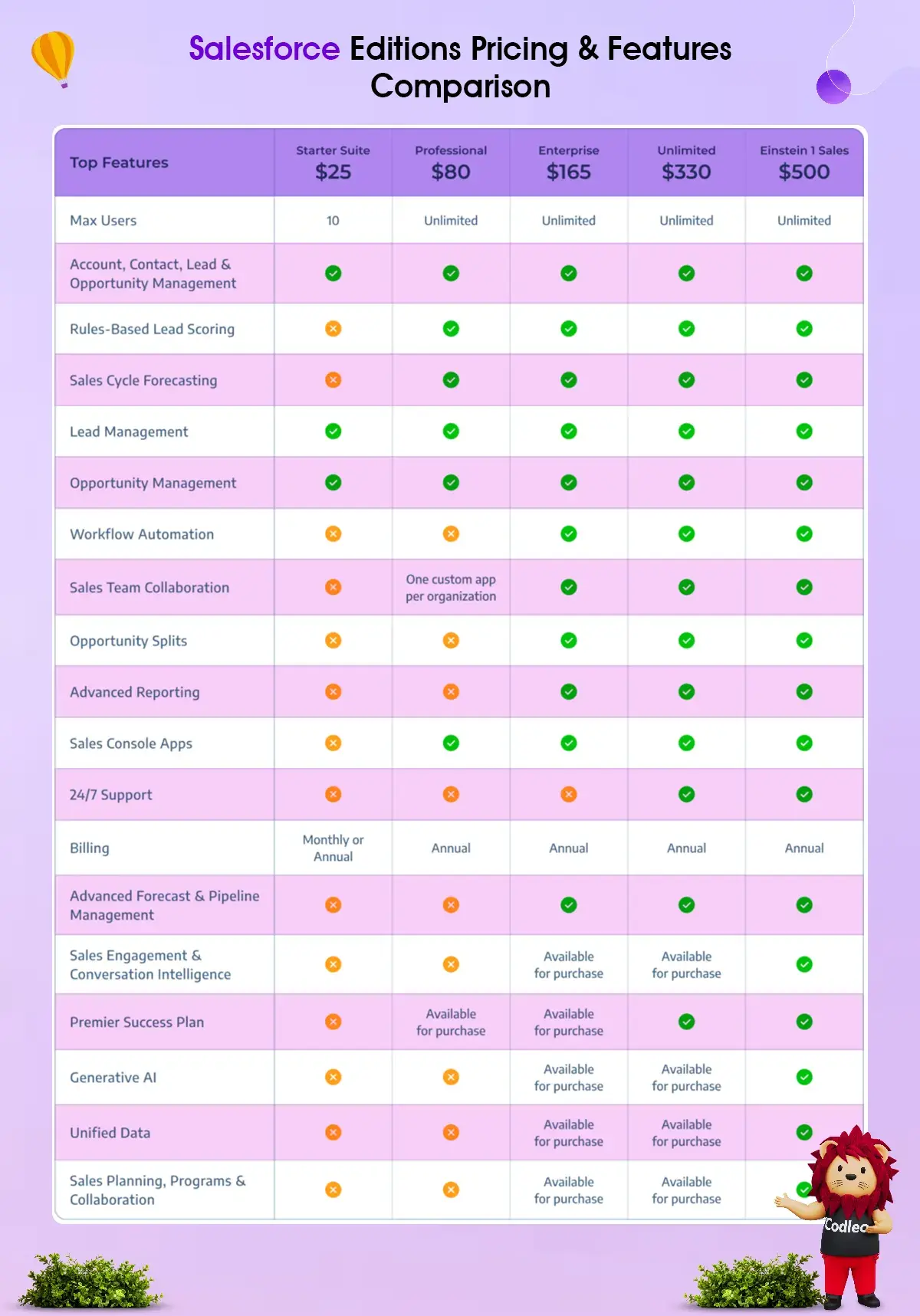
Salesforce Editions Cost Breakdown
-
Starter/Essentials Edition: This service provides easy tools for managing contacts, leads, and opportunities, specifically designed for small businesses. It costs $25 per user each month, billed annually. The Essentials Edition offers straightforward CRM tools to help small businesses keep track of their contacts, leads, and opportunities.
-
Professional Edition: This is suitable for mid-sized teams and costs $75 per user each month, billed annually. It offers complete CRM features, with improved sales forecasting and automation.
-
Enterprise Edition: Large organizations can choose this plan for $150 per user each month, billed annually. This plan provides deep customization, advanced reporting, and integration options to meet complex business needs.
-
Unlimited Edition: The complete package costs $330 per user per month when paid annually. It includes full functionality, 24/7 support, and premium features like generative AI.
-
Einstein 1 Sales Edition: This solution offers strong features, including AI capabilities, for $500 per user per month.
Salesforce Foundations is a set of free features for all Salesforce Sales Cloud and Service Cloud customers using the Enterprise or Unlimited editions. It includes key features from Data Cloud, Marketing, Commerce, Service, Sales, and Agentforce.
Salesforce offers different types of user licenses that determine what each user can access. While the overall Salesforce edition applies to the entire organization, licenses are assigned to individual users based on their job needs.
Each license type grants different permissions, profiles, and access levels, which you can customize. This way, organizations only pay for what each user actually needs.
How Salesforce User Licenses and Feature Licenses Differ
Salesforce has two main types of user licenses that work together to create a customized access model.
Every Salesforce user needs one user license, which sets their basic level of access. These licenses provide essential CRM functions and allow users to access standard objects.
-
Accounts,
-
Contacts,
-
Leads,
-
Opportunities.
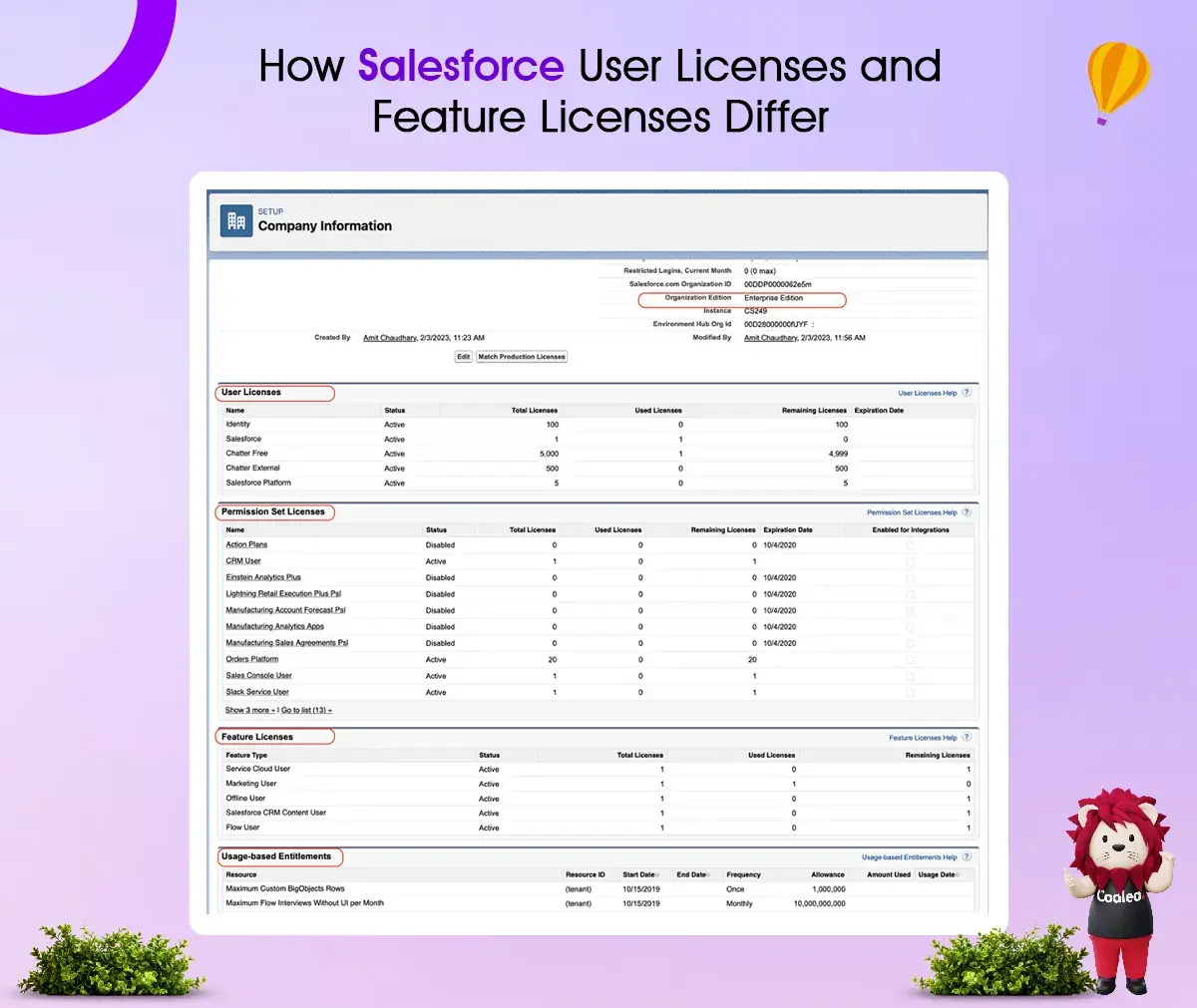
Popular Salesforce license types include:
-
Salesforce offers two types of full CRM licenses. The Starter Suite costs $25 for each user per month. The Pro Suite costs $100 for each user per month.
-
Salesforce Platform license types: Platform Starter costs $25 per user/month, Platform Plus costs $100 per user/month.
-
Identity licenses (including Identity Only, External Identity, and Identity Verification Credits Add-On Licenses) come at no extra cost with the Enterprise and Unlimited editions. If you want a standalone Identity license, it costs $5 per user per month.
-
Salesforce Integration licenses are available with the Enterprise, Unlimited, and Performance editions. Each of these editions provides five free integration licenses per organization. The Developer Edition includes one free license. If you need more licenses, it will cost $10 per user each month.
-
There are different types of usage-based licenses.
-
For Customer Community, login-based licenses cost $2 per login each month. For Partner Community, the cost is $10 per login each month.
-
Storing an extra 500 MB of data costs $125 each month. API usage depends on your license type. If you exceed the limits, you may face additional charges or need to upgrade your license.
-
Advanced AI solutions, such as Agentforce AI agents, cost $2 for each conversation.
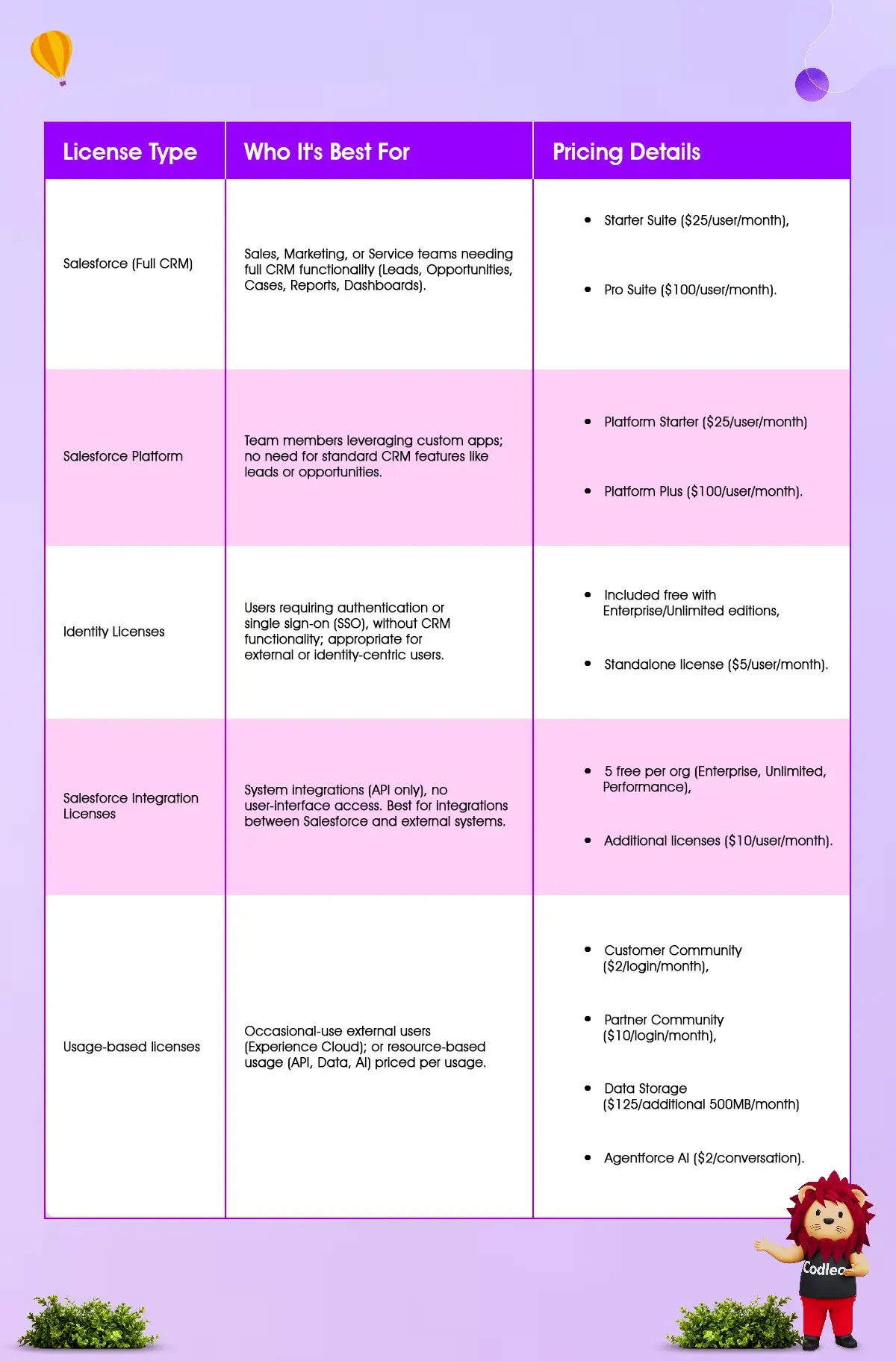
Each user gets a core Salesforce license, which provides the basic features they need.
Salesforce user licenses include permission sets that offer additional access to features beyond the basic options. There are also permission set licenses that provide access to even more features not included in the main user license.
Salesforce Feature licenses are add-ons that provide access to specific features beyond what standard user licenses offer.
Users can have several feature licenses at once. For example:
-
Marketing User license,
-
Flow User license,
-
Salesforce CRM Content user license,
-
Knowledge Only User license,
-
Service Cloud User license.
The concepts connect in this order:
-
The organization purchases a Salesforce edition,
-
Admin purchases appropriate license types,
-
User licenses are assigned to individual users,
-
Feature licenses are added as needed for specialized functionality.
This layered structure helps reduce costs by providing each user with the access they need, instead of giving everyone all the features.
What is the cost of Salesforce licenses for a small or medium-sized business (SMB)?
Innovative Technologies Solutions is a small consulting and services company focused on technology. It has 25 employees.
They use Salesforce as their primary tool to manage customer interactions, run their operations, and connect with external communities.
Let’s look at the potential costs of Salesforce licenses for Innovative Technologies Solutions. We will calculate the average fees for different internal and external user licenses based on user roles and needs.
Company User Profiles and Needs:
Internal (Employee) users (20 licenses):
-
Sales & Marketing Team (8 employees): The system needs complete CRM features and full access to Sales Cloud.
-
Operations and Admin Team (6 employees): It only needs limited access to custom apps and does not require access to Leads and Opportunities.
-
Developers & IT (2 employees): They need licenses for Integration User, and they only manage API connections.
-
HR team & executives (4 employees): They need licenses that allow them to log in and access the HR portal using Salesforce Single Sign-On. It does not include any CRM features.
External users approximately (monthly usage-based):
-
Partners and resellers log in to the Partner Community about 100 times each month.
-
Around 200 customers log in to the support portal each month.
Salesforce Licensing Calculation:
Internal Licenses:
-
Salesforce CRM Full License (“Pro Suite”) costs $100 per user per month for a Sales & Marketing Team of 8 users. It totals $800 each month.
-
Salesforce Platform Starter License for an Operations/Admin Team costs $150 per month for six users at $25 per user.
-
You get 5 Salesforce Integration Licenses for free with the Enterprise and Performance editions. There is no extra cost for these licenses—monthly fee: $0 (included).
-
We will provide Identity Only Licenses (Single Sign-On) for four users—HR and Executives—for $5 per user each month. It totals $20 per month.
Monthly Total Internal License Cost: $970/month
External Licenses (Usage-Based):
- If you are part of our partner community and have a login-based license, you can have 100 monthly logins. Each login costs $10 per user per month. It means your total will be $1,000 each month.
- Customers with a login-based license can access the community for $2 per login each month. If there are 200 logins, the total cost will be $400 per month.
Monthly Total External License Cost: $2,370
The total cost for Salesforce licenses each year will be $28,440.
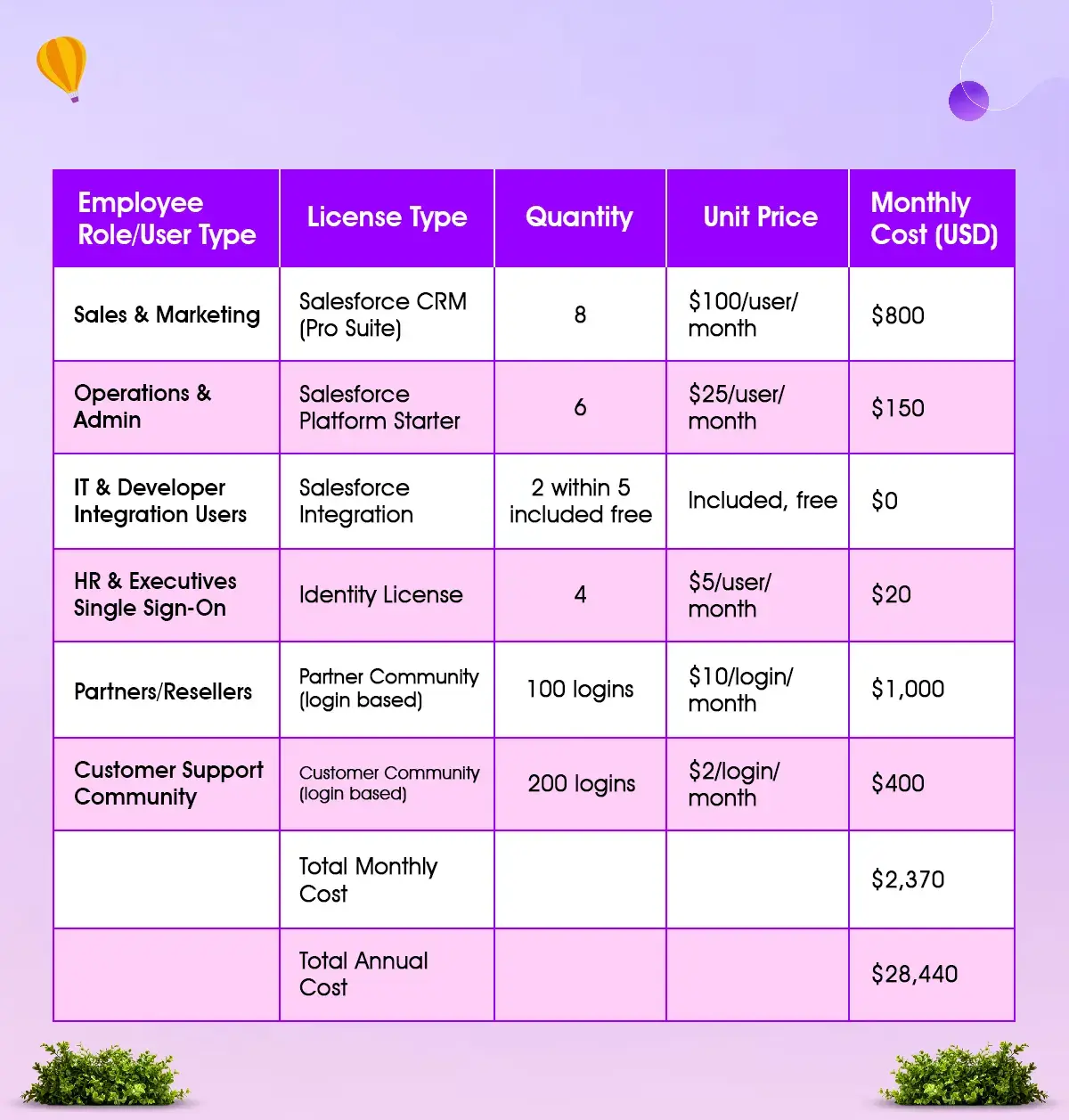
Additional Costs (Optional):
-
Extra Data Storage or API use costs $125 per month for each additional 500 MB.
-
Agentforce AI Agents: $2 per AI conversation (optional)
It is a simple pricing example for a small business using Salesforce. It shows typical licensing costs you might encounter. Actual costs can differ based on the edition you choose, any negotiations, additional needs, contracts, and available discounts or promotions.
Nonprofit Cloud License Types and Pricing
Salesforce understands that nonprofits are unique and powerful. To help them achieve their goals, Salesforce provides special licensing options through its Nonprofit Cloud platform.
These licenses help nonprofits manage donor relationships, raise funds, track grants, manage programs, and generate reports more easily.
Let’s look at the main licenses, offerings, and programs for nonprofit organizations.

The Power of Us Program helps nonprofits.
Salesforce supports nonprofit organizations and helps them grow through its Power of Us Program. The company is dedicated to making a positive social impact.
This program helps nonprofits get started with Salesforce for free. It also offers discounts for future expansions.
Through the Power of Us Program, qualified nonprofit organizations receive:
-
10 free licenses for Salesforce Nonprofit Cloud or Sales/Service Cloud Enterprise Edition.
-
Special pricing for extra licenses, upgrades, and other Salesforce products.
Salesforce helps nonprofits use powerful technology at no cost so that they can focus on their essential work.
Salesforce Nonprofit Cloud: Editions and Pricing Options
Salesforce Nonprofit Cloud offers solutions for organizations ranging from small, growing nonprofits to larger, established ones.
Salesforce Nonprofit Cloud: Enterprise Edition
-
The cost is $60 per user, per month, billed annually.
This solution is ideal for midsize nonprofits that need an affordable, effective CRM for fundraising, donor management, activity tracking, financial reporting, relationship maintenance, and program oversight.
Key Features:
-
Nonprofit Data Model for organized data management and insights.
-
Nonprofit Toolkit and Accounting Subledger for simpler accounting.
-
Nonprofit Copilot Actions for efficient guidance in your CRM tasks.
Salesforce Nonprofit Cloud: Unlimited Edition
-
The cost is $100 per user each month, billed annually.
This edition is designed for larger or fast-growing nonprofits. It offers flexible customization, more storage, automation, priority support, and testing options to help them scale.
Key Features:
All features of the Enterprise Edition are included.
You get more storage for data and files, along with more customization options.
The Premier Success Plan provides personalized coaching, expert 24/7 support, and a dedicated Full Sandbox for testing updates and features.
Salesforce Nonprofit Cloud with Einstein: Version 1 for Sales.
-
The cost is $300 per user per month, billed annually.
This option is for nonprofit teams that want to improve fundraising, engage donors, and build strong relationships. It offers advanced insights and predictions using data analytics and an AI-powered CRM.
Key Features:
-
Unlimited Edition features
-
Einstein for Sales, which helps predict outcomes and provide insights
-
Experience Cloud and Data Cloud for managing donors and analyzing engagement
-
Salesforce tools for productivity and collaboration, including Salesforce Maps, Salesforce Scheduler, Slack Enterprise Grid, Slack Sales Elevate, and Sales Enablement
Nonprofit Cloud Einstein 1 for Service
-
The cost is $300 per user, per month, billed annually.
It is for nonprofit organizations that provide excellent service. It includes donor support programs, volunteer helplines, member services, and customized outreach in a data-rich environment.
Key Features:
-
This package includes everything from the Unlimited Edition and advanced features of Einstein for Service AI to help manage services better. It also offers Data Cloud and Experience Cloud for insights into customer service and personalized interactions. You get Service Cloud Voice, tools for digital engagement, Einstein Conversation Insights, Salesforce Scheduler, and team collaboration through Slack Enterprise Grid.
Salesforce Nonprofit Cloud for Grantmaking: Enterprise Edition.
Grant processes are different from fundraising. To support this, Salesforce has created special license editions for nonprofits that focus on grantmaking and management.
Nonprofits that work with grant applications, management, and reporting can use special licenses to access improved features in Salesforce.
-
The cost is $175 per user, per month, billed annually.
Nonprofits can effectively manage external grant applications, allocate budget resources, evaluate grants, and create personalized experiences for grantees using branded portals.
Key Features:
-
Access Salesforce Sales and Service Cloud.
-
Use tools for managing applications and budgets.
-
Enjoy features for grantseekers and grantees, with 100 Customer Community+ login licenses included for external users and partners.
Salesforce Nonprofit Cloud for Grantmaking: Unlimited Edition.
-
The cost is $225 per user, per month, and is billed annually.
This system is intended for organizations that manage large, complex grant programs. It offers plenty of storage, automation options, custom workflows, full support, and seamless integration throughout the entire grantmaking process.
Key Features:
-
All the features of the Enterprise Edition, along with extra customizations, automation, and integrations.
-
We offer more storage and automation features to manage grants effectively. The Premier Success Plan includes specialized support, expert coaching, 24/7 assistance, and a Full Sandbox testing environment.
What is the Nonprofit Success Pack (NPSP)?
The Nonprofit Success Pack (NPSP) was Salesforce’s original system specifically designed for nonprofit organizations. It offered free and open-source tools to support these groups in their missions. The NPSP customized the Salesforce platform to address nonprofit needs, including donor relationship management, grants management, and fundraising.
The Nonprofit Success Pack (NPSP) is Salesforce’s original system designed for nonprofit organizations. It provides free and open-source tools to help these groups with their work. The NPSP customizes the Salesforce platform to meet the needs of nonprofits, including donor relationship and grant management.
Types of Licenses and Pricing Models for Marketing Cloud and Pardot
Marketing Cloud has a unique licensing approach compared to other Salesforce products. It charges based on your organization, not on the number of users. You can buy modules called Studios and Builders based on your needs.
Marketing Cloud offers different bundles with varying editions and prices:
-
Marketing Cloud Engagement editions start at $1,250 per organization per month.
-
Marketing Cloud Intelligence editions start at $3,000 per organization per month.
-
Marketing Cloud Personalization editions start at $108,000 per organization per year.
-
Marketing Cloud Growth Edition starts at $1,500 per organization per month.
-
Loyalty Management editions start at $20,000 per organization per month.
-
- Data Cloud for Marketing costs $108,000 per organization per year.
Your total cost may change based on the modules you select and the size of your organization.
Account Engagement (formerly known as Pardot) also uses a per-organization billing model. Multiple users can access the platform with one license. The pricing for Account Engagement is as follows:
-
Growth Edition: Start your B2B marketing at $1,250 per month.
-
Plus Edition: Get mid-tier features for $2,500 per month.
-
Advanced Edition: Access complete marketing features for $4,000 per month.
-
Premium Edition: Use enterprise-grade tools for $15,000 per month.
Pardot editions have different contact limit restrictions. Most editions support up to 10,000 contacts, while the Premium edition supports 75,000. You can purchase additional contacts in groups of 10,000.

Salesforce Marketing Cloud offers different pricing tiers for its products and integrations. Each tier provides more advanced features. The Advanced and Premium editions include custom objects and dedicated IP addresses. The Growth tier has basic features but limits the number of forms, landing pages, and automation rules.
Choose the correct license type based on your business needs, number of users, and budget. Good license options can help you save money while providing all the features you need.
Limitations of Each Type of Salesforce License
Knowing the different types of Salesforce licenses and their limits is crucial for managing costs and maintaining compliance. Each license type has specific rules that influence how you implement Salesforce.
Limits on Custom Objects in Platform Starter and Platform Plus
Platform licenses have strict rules governing access to custom objects. With Platform Starter (formerly Lightning Platform), users can access only 10 custom objects each. In contrast, Platform Plus (formerly Lightning Platform Plus) provides access to 110 custom objects per user, giving teams greater flexibility to build complex applications.
You can assign more custom objects through permission sets without hitting a technical wall. However, exceeding your allowed custom object limit goes against your agreement with Salesforce, and you may be charged for any past usage.
Salesforce does not allow the creation of custom objects that duplicate standard features to avoid incurring a fee. For example, building a system similar to Opportunities using custom objects violates Salesforce's rules and could result in penalties.
API-only access is a feature available in the Salesforce Integration User License.
The Salesforce Integration User license, introduced in March 2023, is designed for system-to-system integrations. These licenses work only with APIs, so users cannot access the Salesforce interface directly. Organizations with the Performance, Enterprise, or Unlimited edition receive five free Integration User licenses.
-
Developer organizations receive a special license that requires careful management of permissions. You can only change permissions using permission sets, not at the profile level. Users must have the "Modify Metadata Through Metadata API Functions" and "Customize Application" permissions. All interactions occur via REST, SOAP, or Bulk APIs due to the API-only restriction.
Einstein License Restrictions Based on Edition and Features
Einstein features vary depending on the Salesforce edition you choose. The Enterprise edition and higher include features such as Einstein Search and Opportunity Scoring. The Unlimited edition offers most Einstein features at no extra cost.
For Enterprise and Performance editions, you will need to spend additional money beyond the base license to access many Einstein capabilities. Organizations need to evaluate which Einstein features they need before deciding on a Salesforce edition.
Einstein's licensing model is different from standard user licenses. Its availability usually connects to specific Salesforce products and editions, rather than being available as standalone options.
How to Review Your Current Salesforce Licenses
A Salesforce license audit can help you save costs—up to 30%, according to Gartner research. Regular audits are essential for understanding how your organization uses these licenses and for cutting unnecessary expenses.
Here are some practical ways to check your current Salesforce license setup.
How to Check Your Salesforce License Count
To start any Salesforce license audit, go to the Company Information section.
Here’s how to find it:
1. From Setup, type “Company Information” in the Quick Find box.
2. Click on the link that appears to view your organization’s details.
In this section, you will see important information about your licenses, including:
-
The total number of licenses purchased, categorized by type.
-
The number of licenses currently in use.
-
The number of available licenses left for assignment.
-
The expiration dates for your license agreements.
This view provides quick access to your license usage without running complex reports.
The Feature License section lists special license types, such as Marketing User, Service Cloud User, and Flow User. This information is not available in standard reports.
Be careful with Integration User licenses. These licenses are valid for API-only access with tools like Marketo or HubSpot when you don’t need to log in to an interface.
Exporting License Data Using Salesforce Reports
Salesforce provides several ways to manage license allocation. One option is to create standard user reports to track user login patterns and license assignments.
To build a report that identifies inactive users, follow these steps:
1. Use the “Users” standard report type to create a report.
2. Set a filter for “Last Login” that is not equal to the last 30 days.
3. Add columns for “Full Name” and any other relevant user data.
4. Include a row-level formula to show “Days Since Last Login” using: TODAY() – DATEVALUE(LAST_LOGIN).
5. Sort the report by “Days Since Last Login” in descending order.
Reports on Permission Set License Assignments.
To find out which licenses are assigned to specific users, follow these steps:
-
Create a custom report using Permission Set License Assignments as the main object.
-
Add relevant fields like the user's full name, the permission set license name, and the user license name.
-
Filter the report by the specific users you need.
You can export these reports as CSV or Excel files for offline use or to share with others. If you choose the “Formatted Report” option, the export will retain your formatting.
How to Identify Underutilized or Inactive Licenses
Only 47% of Salesforce licenses are actively used. Here’s how to identify underused licenses:
1. Set clear metrics:
-
Look for users who haven’t logged in for 30 to 60 days.
-
Check for little or no activity with important objects like opportunities and accounts.
-
Note low usage of key features relevant to their job roles.
2. Analyze login patterns:
-
Review usage trends by department and function to identify teams that use the system less.
3. Understand license assignments:
-
Ask users to explain why they need specific licenses before granting access.
4. Monitor seasonal patterns:
-
Some roles only need full licenses at certain times, so reallocate licenses to optimize usage throughout the year.
5. Reassign inactive licenses:
-
Transfer licenses from inactive users to new users or switch them to cheaper types.
6. Consider deactivation:
-
Temporarily deactivate licenses for users who haven’t logged in for 45 to 60 days.
7. Conduct regular audits:
-
Include license audits in your Salesforce governance. Review your licenses every quarter to ensure optimal distribution as your organization grows.
Strategies for Optimizing Salesforce Licenses to Save 40%
You can save up to 40% on subscription costs by optimizing your Salesforce licenses. Many companies waste money due to poor license management. Before buying new licenses, try these cost-saving methods.
Tip #1: Reassign Unused Licenses to New Users
Many companies pay for licenses that go unused. Here’s how to find these opportunities:
-
Check for users who have been inactive for 45-60 days.
-
Ask team leaders if those users still need access.
-
Make sure to get clear reasons before giving out new licenses.
You can easily deactivate unused licenses without losing user data, and reactivate users when needed. Start with teams that use licenses seasonally, as these often sit idle during quiet times.
Tip #2: Switch to platform licenses for internal applications.
If your team primarily uses custom apps rather than the complete CRM, consider using Platform licenses to save money.
-
Platform Starter allows you to use 10 custom objects at a lower cost.
-
Platform Plus lets you access 110 custom objects.
These licenses are a good fit for:
-
Post-sales teams that don’t use Opportunities,
-
Teams that mostly use Managed Packages,
-
Nonprofits with non-standard business setups.
Keep in mind that switching from complete Salesforce to Platform licenses will remove all permission sets. You will need to set up new permissions after making the switch.
Tip #3: Use Identity Licenses for Users Who Only Need SSO
Salesforce Identity licenses let users sign in without using the full CRM features. These licenses are ideal for:
-
Staff who only need identity services,
-
Account Engagement users accessing Lightning apps,
-
People who need to log in to multiple systems.
The Salesforce Identity license includes key features like Single Sign-On, Multi-Factor Authentication, App Launcher, and Connected Apps. The Identity Plus version offers better security and integration options.
Your company gets 100 identity licenses with Account Engagement. If you already use these tools, this is a quick way to save money.
How Codleo Can Assist in Optimizing License Costs
Looking for a licensing plan that fits your budget? Hire Codleo, a certified Salesforce consultant, to help you manage your Salesforce license costs and usage effectively.
With over 10 years of experience, we understand how to improve Salesforce license management.
We will help your organization maximize its Salesforce investment by delivering cost savings and improved efficiency and productivity.
We can help you with several important aspects of using Salesforce:
-
Calculate the actual cost of migrating to Salesforce, including any hidden expenses.
-
Lower the upfront costs of implementing Salesforce by selecting the right edition and licenses, and by analyzing your business structure to streamline system access.
-
Maximize the use of all Salesforce licenses in your organization and improve license management.
-
Cut development costs by using effective techniques and managing the risks of technical debt.
-
Optimize the costs of integrating Salesforce by selecting or creating the right tools to connect with your existing solutions.
-
Reduce the expenses involved in developing and approving your AppExchange app.
-
Cost-effectively expand system features while maintaining your budget focus.
-
Make the most of your licenses with each new release, and benefit from all Salesforce updates through our virtual support and administration services.
If you're confused about Salesforce license types and editions, have questions about subscription costs, or need assistance understanding the cost structure, contact us for a free consultation today!
FAQ
A Salesforce license is a contract that outlines the features and services a user or organization can access within Salesforce. Licenses are necessary because they establish users' basic access and functions and help ensure that users follow Salesforce’s terms of service. This helps prevent legal and financial issues.
There are more than 100 types of Salesforce licenses, including standard user licenses, feature licenses, permission sets, usage-based licenses, and specialty licenses.
Internal Salesforce licenses are for your employees. They provide full access to the Salesforce platform, including CRM tools and internal data. External permits are meant for users outside your organization, like customers or partners. These licenses allow limited access to specific data and features through Experience Cloud sites for their interactions.
Experience Cloud licenses, previously called Salesforce Community licenses, are designed for external users like customers, partners, or vendors. These licenses allow them to access specific Salesforce data and features through branded portals, but their access is limited.
Standard CRM licenses, like Sales or Service Cloud, are for internal employees and provide full access to all Salesforce CRM features, such as leads, opportunities, reports, and dashboards. Community licenses are generally more affordable and designed for specific external collaboration situations. In contrast, standard CRM licenses are meant for internal business processes.






